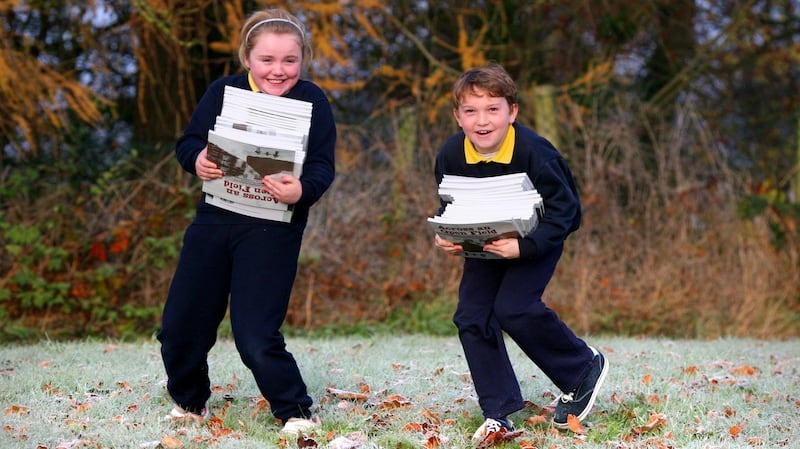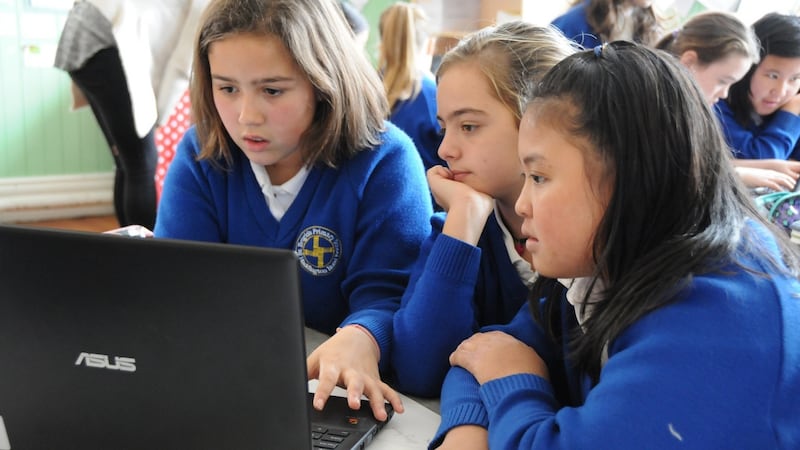It was one of the most successful children’s projects in the history of the State.
In 1937, 100,000 school primary school pupils were tasked with gathering folklore and oral histories from their families and communities, ultimately gathering more than half a million pages of information about local history, customs and beliefs, legends and folktales, songs and much more, which now form a part of the National Folklore Collection at UCD.
It was a revolutionary model, far ahead of its time, showing that children could be diligent and valuable generators of knowledge instead of just passive absorbers.
Since that project, the notion of a new school folklore scheme has been mooted many times, but nothing of its scale has been carried out.
Now, however, a book from the Kids Own Publishing Partnership has tapped into this radical spirit once again.
Mary Branley was a writer-mentor on the project which resulted in Across an Open Field, featuring stories and artwork from Ireland and Northern Ireland about the decade of commemorations of 1912-1922.
She helped support 300 children in their work by travelling to four schools in Northern Ireland and six in the Republic.
Radical policy
“The Kids Own policy of working with children is radical: children are the writers, illustrators and designers, in a process that unfolds through the children’s interests, experiences or, in this case, research,” she says.
“We started by meeting the children in their schools and brainstorming on how they could carry out research into life around them 100 years ago.”
The children brought a number of artefacts to the process including cuttings from local papers, coins, letters from soldiers and old photographs, all providing a window into life in the time of their great-grandparents and beyond.

They drew on local places of historical interest: children in Inchicore, Dublin, went to Kilmainham Jail; some children in Belfast visited Belfast Jail to research the suffragette movement; children in Clones (Monaghan) and Dromkeen (Limerick) looked at local massacres that occurred during the War of Independence; girls in Haddington Road (Dublin) looked at the 1913 lockout which had local resonance; the Titanic featured heavily in Belfast. Family and community memories of the first World War featured heavily for all the children.
Branley trained and worked as a teacher, working for 10 years with special-needs children in Sligo, London and Boston, and with children from the Traveller community.
During this time, she collected Traveller nursery rhymes from children and, using the children’s artwork and design, published her first book with Kids’ Own. She now works on different projects helping children to write about their lives and experiences.
“It started as a way of helping children on the margins to articulate their realities and has grown since,” she says.
“I collect the stories, type them up and ask the children if they want to change anything; they do the revisions themselves.
“The work is collective and children form a shared vision together, and together we have written fiction and non-fiction, including a novel where the kids worked together on writing, illustration, plot and character development.”
Pioneering aviator
Conor Doyle is a teacher in a Lisnafunchin, a small, two-teacher school near Castlecomer, Co Kilkenny and his pupils took part in the project.
"I found old stories from the Kilkenny People on microfiche about Denys Corbett Wilson, a pioneering aviator from a rich aristocratic background who did test flights around Kilkenny around 1912 and 1914, and the children wrote about him," he says.
“One of the children had a great-grandmother who had been a child in 1916 Dublin, and stories of her experiences in the Rising had been passed down in the family. Another local story was about two brothers who joined the British army and died in the first World War aged just 19 and 20.
“Their nephew, Paddy Dowling, had grown up and had never been told about them until, in the last few years, he was cleaning of the attic of his grandmother – the mother of these boys – and found war medals and official letters of condolence from Buckingham Palace thanking them for their sons service in the war and other correspondence from prison camps where one of the brothers spent time before his death.
“Paddy brought all these artefacts into school during the project and the children were able to handle them, study them, listen to the stories of the family and imagine their experiences.”
Catherine McParland, a teacher in Gaelscoil na bhFál, Belfast, another school which took part in the project, says: “We like new ideas and projects and were excited about exploring life in Belfast 100 years ago.
“Mary Branley visited us and asked the children, who were about eight or nine, to draw pictures of how they imagined life 100 years ago. The children went home and asked about their grandparents, and found that a lot of them were mill and dock workers, shipyard workers and soldiers.
"It was a good way to explore the Titanic and, by investigating what houses were like 100 years ago, we could see how people lived.
“The project tied in well with the curriculum as we picked themes that covered history, science and geography and it lent itself to art and literacy. We’ve now taken it on as a project in the school.”
Branley believes the Kids Own model is an innovative approach to education. “I’m always astonished at the creativity and talent of children,” she says.
“Children’s literature is usually handed down from adults; It’s time for children’s literature to also embrace children as artists and writers.”
For more information on these books created by children in Ireland, see KidsOwn.ie

Extracts from Across an Open Field:
“The average time a pilot would spend in war, before he was shot down, was two weeks but Denys Corbett Wilson lasted six or seven months in the war as a fighter pilot. His mother sent him clothes and food to the front. He got shot down flying over a German base, trying to figure out where they were. His plane was shelled and he died on May 10th, 1915.”
Text researched and written by children from Lisnafunchin NS, Castlecomer, Co Kilkenny
“Patrick was born in Belfast and was involved in the Easter Rising as a volunteer. He was under the command of Éamon de Valera at Boland’s Mill in Ringsend. Crossing Baggot Bridge he was shot by a British soldier and killed. But to this day his great great nephew Naoise is involved in the Irish language and helping out in sport in Belfast.”
Matthew, Gaelscoil na bhFál, Belfast









